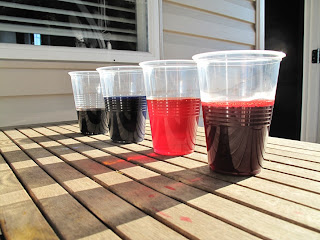However, under my login, Safari has disappeared. So here I am logged in under the kid's account, but the kid doesn't have access to my Pictures folder. So I'm going to fix the Safari problem on my account rather than mess with her access, and I'll be back in two shakes.
Okay, here we are, back to our regularly scheduled programming. Below are my socks-in-progress at the start of the weekend. The one on the left almost had a heel and the one on the right totally did not. Not even close. Not even started. Hubby decided that since we were at Whipsaw, and since they were socks, they shall be named Whipsocks. I'm totally on board with that.
Below is Dick's cabin and it's the second cabin that you get to when you're following the trail from the Hwy 3 side. I'm not sure whether Dick built it, or if it's just named for him, but there you go.
Dick's cross is in the front yard. I'm pretty sure Dick's not buried there, but you never know.
These dogs did too.
This is Dillon, just up from Memorial Rock, which we encountered on Day 2. Memorial Rock is so named for another fellow who really liked the Whipsaw trail. I tried to find the photo that has his plaque in it, but it's hiding. Memorial Rock was covered in dirt this weekend, so I couldn't get a picture of it. Plus, there were 18 Jeeps driving all over the place and it would have been like Frogger to try to do anything on the rock face. Dillon's Jeep is wearing Trail Skinz.
This is a tiny piece of the trillion-flower garden that grows in the mountains around the Whipsaw trail. The minute the snow has melted, the flowers are starting and within days there's a covering like you wouldn't believe. Plants move fast when their growing season is so short. And they really know how to be colourful.
Okay, here we are back at Memorial Rock and this is a tire in the air.
This is my hubby driving up the very steep face of Memorial Rock. Those wires going from the good to the top of the windshield are Limb Riserz, made by the fine people at Trail Skinz.
This is how steep it is. See how the people are standing? How the trees are? When you are on the ground and you're looking at the rock face, it wouldn't occur to you to drive up it (* if you own a Jeep or other four-wheeler, you would look at it and want to drive up it). See the Trail Skinz? When you're driving down a backwoods trail and the trees and brushing and scraping against the sides of your vehicle, we call that a BC Car Wash. The Trail Skins keep the scratches out.
These are the Whipsocks against the background of the wee meadow in the overflow area at Wells Lake. If you're lucky, you get the spot right by the lake that has a shelter and some seating (and a view of the lake), but if you're us, you always seem to get the meadow a bit of a ways from the lake. There are two socks with heels in this photo.
This is our campsite, with the wee tent for two and the Hood Skinz on the Jeep. They have skulls on them. We just have them because they look cool, although another friend has them in black to cut down on reflection from his massive lights.
That about wraps it up. The socks have an inch or two of leg on them now and I'm going to do a swirly rib up the length of them. It's KnitPicks Felici fingering-weight yarn, in case you're wondering. I was a bit annoyed with it, but I'm getting over it - the striping is opposite. The socks are knit so that each has its own ball, and they're knit at the same time. They are both centre-pull balls and I should have rewound one (clearly) because they have stripes that are opposite to each other, colour-wise. It reminds me of the no-matchy-matchy fiasco with the Chroma yarn. Upways or downways, those things weren't matching.










































